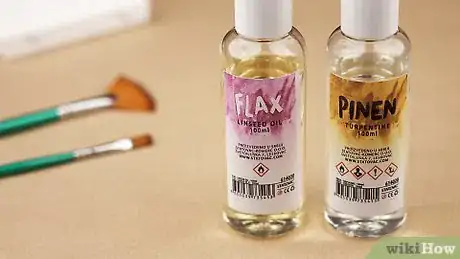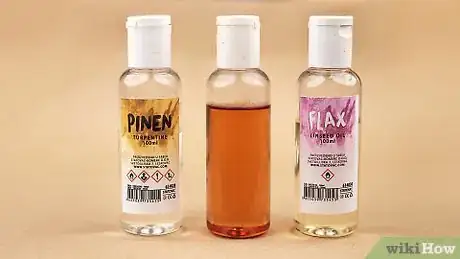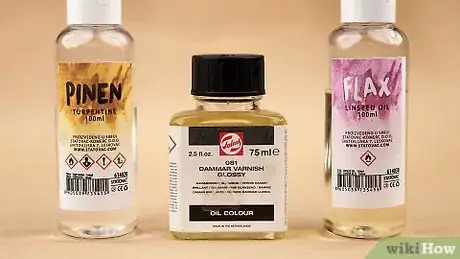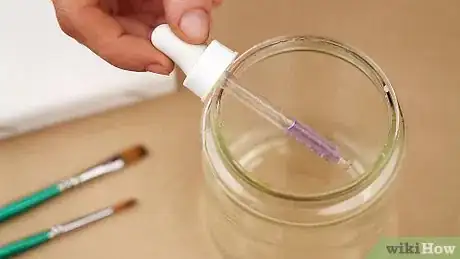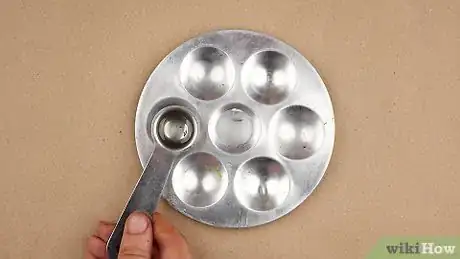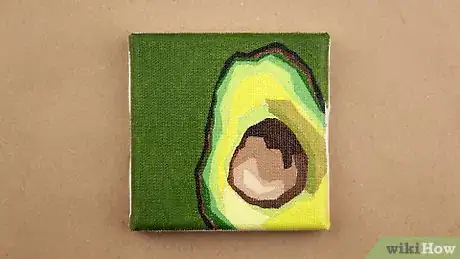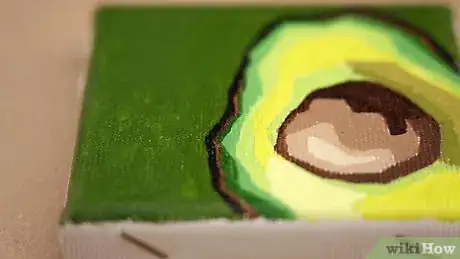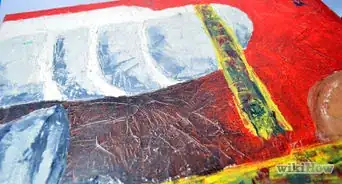This article was co-authored by wikiHow staff writer, Jessica Gibson. Jessica Gibson is a Writer and Editor who's been with wikiHow since 2014. After completing a year of art studies at the Emily Carr University in Vancouver, she graduated from Columbia College with a BA in History. Jessica also completed an MA in History from The University of Oregon in 2013.
The wikiHow Video Team also followed the article's instructions and verified that they work.
This article has been viewed 113,386 times.
Learn more...
While paint will give an oil painting its shape and color, a glaze will make it shine. You can buy a glaze from a store, but if you're a DIY sort, you can make some of your own. By making your own glaze, you'll have that much more satisfaction when you create art with it. Although all oil glazes will use turpentine as a base ingredient, you can choose a recipe based on the ingredients you have available. By trying out different oils and varnish, you can help pinpoint a glaze that suits your project.
Steps
Making a Glaze with Turpentine and Stand Oil
-
1Buy linseed stand oil and turpentine from an art store. If you don't have ingredients handy yet, everything you need may be purchased at a local art store. Turpentine and linseed stand oil may be used for a standard oil glaze. Two parts turpentine should be used for each part of stand oil you use. Although linseed and flaxseed oil come from the same plant and are similar, linseed stand oil might have additives to improve its paint-cleaning abilities.[1]
- Because glaze is used in relatively small amounts, you should use the smallest containers available, so long as you're able to get the proportions right. Empty and cleaned baby food jars (about 2 to 4 ounces) are a good size to use.
- Poppy seed oil, walnut oil and other types of linseed oil will work as well. However, these alternatives result in slightly yellowing your painting.
- Mineral spirits may be used in lieu of turpentine if you don't have turpentine available.
-
2Pour stand oil into a mixing jar. Most artists will only need a small amount of glazing medium, so you'll want to create about 2 to 4 ounces of glazing medium. To make this amount, start by pouring about 1 ounce of your linseed stand oil into a resealable airtight jar. Be sure to use a jar that has a screw-top lid so that you can simply screw it on and save unused oil for future use.[2]
- Use caution when handling the linseed oil, since it is highly flammable. If you use any rags to wipe up linseed oil, avoid simply throwing them in the trash since they can spontaneously combust. Instead, soak any linseed oil rags in jar filled with water and take them to a local hazardous waste site for disposal.[3]
- The jar used for mixing should be cleaned out and dried prior to mixing anything. Choose a small jar so that your glazing medium isn't exposed to too much air which could cause it to dry out more quickly.
Advertisement -
3Add two parts turpentine for one part of the oil you're using. Add twice as much turpentine to the jar as the stand oil you added. So, if you've placed 1 ounce of stand oil in your jar, add 2 ounces of turpentine. These two ingredients combined will give you a basic glaze to work with in your paintings.[4]
- Linseed oil is quite thick so you'll need less oil in comparison to the amount of turpentine needed.
-
4Stir the glazing medium. Take a wooden stick (like a craft stick) or use the end of an old paint brush and stir the turpentine and oil. The mixture will need a lot of stirring to combine it. As soon as you've combined the glaze, you can begin to use it (especially because it will begin to separate). You can use the medium directly out of the jar, or pour a small amount into a saucer to use.[5]
- Avoid shaking the glaze. Vigorous shaking will introduce air bubbles into your glaze which could be transferred to your paint. Air bubbles will cause your paint to dry poorly.
-
5Explore different oil and turpentine combinations.[6] The small differences in ingredient proportions will result in slightly different finishes. While linseed oil is typically seen as the go-to oil to use in homemade glazes, many other oils can be used as well. If you want to experiment, you may find certain glazes achieve a different end than others. If you're interested in working with different glaze combinations, you should make multiple batches at the same time. You'll be able to compare them directly with one another this way.
- Glazes will also respond differently based on the makeup of the paint you are using.
Making a Damar Varnish Glaze
-
1Purchase linseed oil, turpentine and Damar varnish. A Damar varnish glaze will give your painting a much stronger shine than the basic turpentine formula. A basic formula is two parts turpentine, one part linseed oil, and 1 part damar varnish. So, you'll need 2 ounces turpentine, 1 ounce linseed oil, and 1 ounce of damar varnish.[7]
- All of these ingredients may be found at a local arts and crafts supplies store.
- This will make about 4 ounces of damar varnish glaze. Depending on how heavily you apply your glaze, this may be too much. Consider making half of this amount and making more as needed.
-
2Pour the ingredients together into a sealable jar. A clear jar is optimal, as it will allow you to observe the ingredient proportions and the mixing process. Take caution while you pour in the ingredients, as turpentine and varnish are flammable. It helps to know the capacity of the jar prior to mixing them. That way, you can fill it up according to the glaze's desired proportions.
- If you use any rags to wipe up linseed oil, avoid simply throwing them in the trash since they can spontaneously combust. Instead, soak any linseed oil rags in jar filled with water and take them to a local hazardous waste site for disposal.[8]
-
3Stir the glazing medium. Take a wooden stick (like a craft stick) or use the end of an old paint brush and stir the turpentine and oil. You can stir the mixture after adding each ingredient so that the glaze combines well. Once the mixture is combined, you can begin to use the glaze. You can use the medium directly out of the jar, or pour a small amount into a saucer to use.[9]
- Don't shake the jar too much before using it. Vigorous shaking will introduce air bubbles into your glaze which could be transferred to your paint. Instead, stir the glaze right before using it.
-
4Add a few drops of lavender oil to your glaze just before using it.[10] Use 3 drops of lavender oil per ounce of glaze you are making. Adding this to the glaze right before using it will give the glaze a thicker body, as well as improve the "wet time" that the artist can work within while painting.
- Look for oil of spike lavender at most fine art supply stores.
Working With Homemade Oil Glaze
-
1Pour a small amount of glaze onto a palette. Because glaze is used in relatively small quantities (only an ounce or two at a time), you should pour out a small amount into the palette you're using to paint with.
- Make sure to keep it separate from other paints and mixtures.
-
2Add paint and glaze together on the brush. Dip your brush in glaze, then add the paint you are using for the area. Combining glaze and paint on the brush will help ensure that the glaze matches the shape you want to have emphasized.
- You should use a high-quality artist's brush in order to get the best effects from your glaze.
-
3Consider using multiple types of glaze in a project. Different combinations of oil will result in different transparencies and shine. Because of this, it may be worthwhile to experiment with a few different types of glaze in your work.
- Using poppy seed oil, for instance, will result in a yellow tinge, which may be desired if you want your painting to look artificially aged.
-
4Allow your painting ample time to dry. Using a glaze with stand oil means your painting will take significantly longer to dry. Because of this, you should allow a full week for an oil glazed painting to properly settle. If you don't want to wait as long, you can minimize your use of glaze, or even go without it entirely.[11]
-
5Use glaze in moderation. Glaze should be used as a way to accent important aspects of the painting's foreground. The effect is lost if you glaze your painting excessively. Try to limit your glaze to the shapes you want to pop out at the viewer.[12]
- You can also apply several light layers of glaze so you have more control. If you apply multiple layers, you may need to mix up more glaze.
-
6Seal the medium when not in use. In order to keep the glaze fresh and useable, keep it sealed whenever you're not using it. It is good to keep the glaze sealed in the jar you made it in.[13]
- When stored in an airtight jar, glazing medium will last several weeks up to a few months. If exposed to air, your glaze will dry out.
Community Q&A
-
QuestionIs it OK if I use sunflower oil?
 Community AnswerSure, but consider that sunflower and poppy oil yellow considerably less than linseed oil (in fact many color manufacturers produce whites with these ones), but have a longer drying time than linseed oil. That can be simply solved with some drops of cobalt dryers or with little amounts of alkyd mediums. Stand oil is thick like honey so the glazing medium will be less liquid, that can be helpful if you like. If you are lazy, you can use just 1 part of Liquin "original" and 1 part of poppy oil or Liquin "light gel" which is already more fluid. Generally, you can use any type of oil, any type of varnish and any type of solvent/mineral spirits.
Community AnswerSure, but consider that sunflower and poppy oil yellow considerably less than linseed oil (in fact many color manufacturers produce whites with these ones), but have a longer drying time than linseed oil. That can be simply solved with some drops of cobalt dryers or with little amounts of alkyd mediums. Stand oil is thick like honey so the glazing medium will be less liquid, that can be helpful if you like. If you are lazy, you can use just 1 part of Liquin "original" and 1 part of poppy oil or Liquin "light gel" which is already more fluid. Generally, you can use any type of oil, any type of varnish and any type of solvent/mineral spirits. -
QuestionFor refined linseed oil, how much turpentine should I use? Is it 2 parts refined linseed oil, and one part turpentine?
 Community AnswerYou can use any amounts you like. If your work (or a specific layer) requires slower drying time, add more oil, if you like a more shining surface, add some varnish, and if you need faster drying time, add more solvent/mineral spirit. You just have to keep in mind that first layers should be thinner while last layers should be thicker according to the "fat over lean" rule.
Community AnswerYou can use any amounts you like. If your work (or a specific layer) requires slower drying time, add more oil, if you like a more shining surface, add some varnish, and if you need faster drying time, add more solvent/mineral spirit. You just have to keep in mind that first layers should be thinner while last layers should be thicker according to the "fat over lean" rule. -
QuestionWhat is stand oil and where do I get it?
 Community AnswerStand oil is a type of oil that helps wet pigments. It may be purchased at any well-stock arts and crafts supplies store.
Community AnswerStand oil is a type of oil that helps wet pigments. It may be purchased at any well-stock arts and crafts supplies store.
Warnings
- These ingredients may be combustible when they're combined. Keep them away from excess heat or any open flames.⧼thumbs_response⧽
- Turpentine is toxic. Make sure not to ingest any while you are mixing it. If for whatever reason it enters your body, call an ambulance immediately.⧼thumbs_response⧽
References
- ↑ http://emptyeasel.com/2007/05/25/how-to-make-oil-painting-medium-by-mixing-linseed-stand-oil-and-turpentine/
- ↑ http://emptyeasel.com/2007/05/25/how-to-make-oil-painting-medium-by-mixing-linseed-stand-oil-and-turpentine/
- ↑ http://abcnews.go.com/GMA/ConsumerNews/summer-safety-diy-dangers-linseed-oil/story?id=11328546
- ↑ http://emptyeasel.com/2007/05/25/how-to-make-oil-painting-medium-by-mixing-linseed-stand-oil-and-turpentine/
- ↑ https://www.youtube.com/watch?v=RcDp90PH6CM
- ↑ https://www.wetcanvas.com/Articles2/59346/619/
- ↑ https://www.wetcanvas.com/Articles2/59346/619/
- ↑ http://abcnews.go.com/GMA/ConsumerNews/summer-safety-diy-dangers-linseed-oil/story?id=11328546
- ↑ https://www.youtube.com/watch?v=RcDp90PH6CM
- ↑ https://www.wetcanvas.com/Articles2/59346/619/
- ↑ http://emptyeasel.com/2007/05/25/how-to-make-oil-painting-medium-by-mixing-linseed-stand-oil-and-turpentine/
- ↑ http://www.artistsandillustrators.co.uk/how-to/oil-painting/235/how-to-layer-colours-5-glazing-essentials
- ↑ http://emptyeasel.com/2007/05/25/how-to-make-oil-painting-medium-by-mixing-linseed-stand-oil-and-turpentine/
